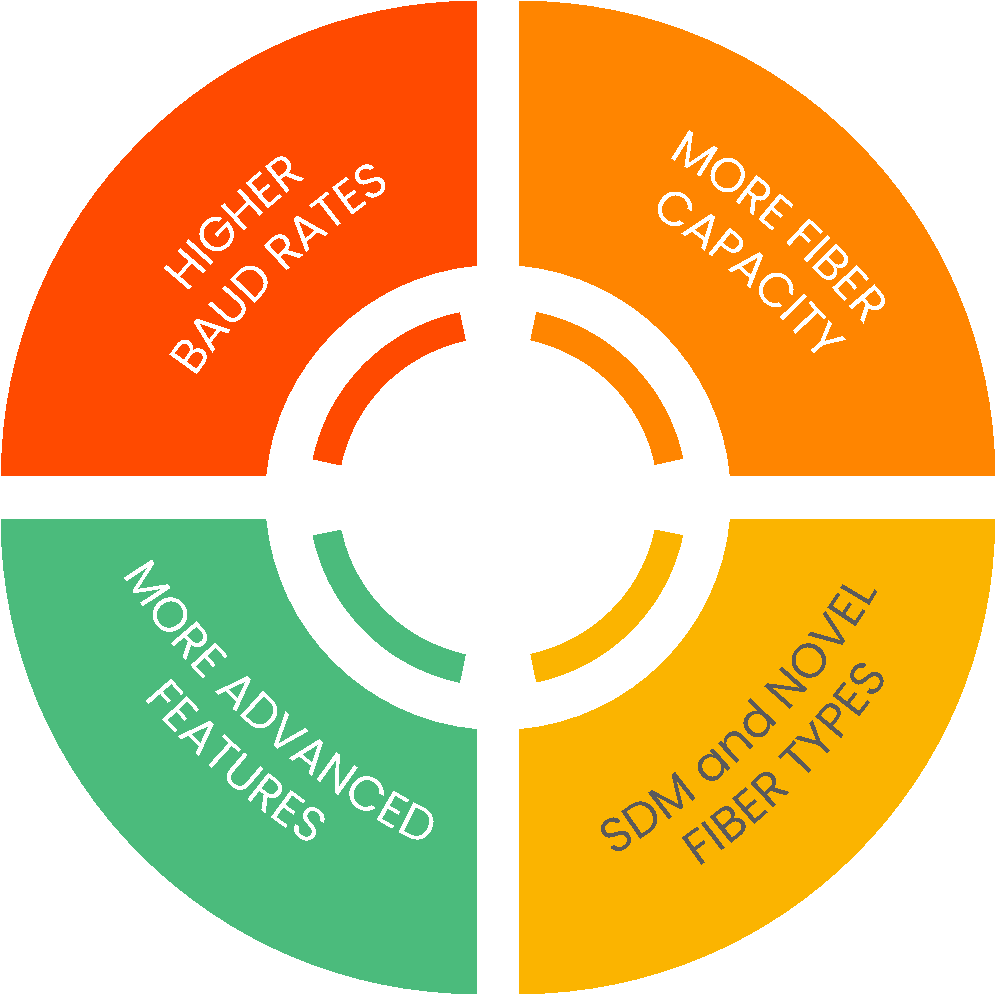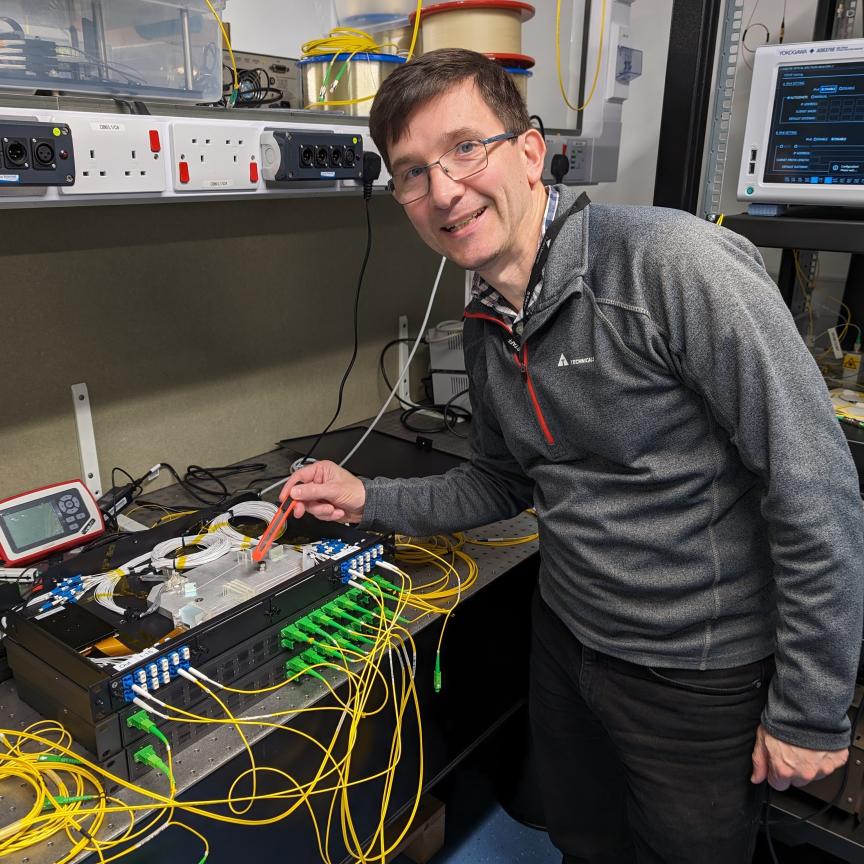Paul Momtahan outlines how coherent optical engine technology is evolving along multiple vectors.
One vector is performance, with high data rates, better reach, and improved spectral efficiency. A second vector is space, power, and cost, while a third vector is the integration of intelligence related to management and performance monitoring.
Compact coherent pluggables prioritise power and space, and in the case of XR optics, manageability and powerful new capabilities such as point-to-multipoint coherent. High-performance embedded engines, less constrained by space and power, prioritise performance, maximising spectral efficiency and driving down cost, space, and power in long-haul and subsea applications. Furthermore, we see high-performance coherent optical engines continuing to evolve in four key areas, as shown in Figure 1.

Figure 1: High-performance embedded coherent evolution
Increased spectral efficiency and fibre capacity
One area in which high-performance embedded engines continue to evolve is spectral efficiency, or enabling the maximum capacity for a given amount of spectrum on the fibre. State-of-the art engines such as Infinera’s ICE6 leverage multiple advanced features like 64QAM-based probabilistic constellation shaping (PCS) and Nyquist subcarriers to get within 1 or 2 dB of the Shannon limit, the theoretical maximum spectral efficiency. But how much closer to the Shannon limit can we get? In theory there is the potential for spectral efficiency improvements in the 20% to 40% range.
For example, a recent Infinera trial with Australia-Japan Cable leveraging next-generation algorithms showed a 17% increase in capacity. In addition to improved spectral efficiency, optical engines are also evolving to make use of more spectrum.
Higher baud rates
Higher baud rates enable better capacity-reach, which drives down the cost and power per bit per kilometre. CMOS process node evolution and photonic improvements have enabled baud rates to evolve from around 30 GBd (100 Gb/s with QPSK, then 200 Gb/s with 16QAM) to around 50 GBd (400 Gb/s), then to 60+ GBd (600 Gb/s), and then to 90+ GBd with 7-nm embedded engines such as Infinera’s 800 Gb/s-per-wave ICE6, with its ICE6 Turbo variant edging above 100 GBd. Recently announced 5-nm embedded engines are in the ~130-148 GBd range, with Infinera’s ICE7 engine leading the 5-nm pack at 148 GBd. 3-nm embedded engines go to 200+ GBd. But where will it end? And do we need ever-higher baud rates?
The road to terabaud?
In terms of the DSP, the CMOS industry has a roadmap through 2034 that will enable increased DSP baud rates, with 2 nm DSP ASICs expected in 2026/2027 and a further reduction (1.5 nm or 1.4 nm) in the future. In terms of modulator material, indium phosphide and lithium niobate both have paths to 200+ GBd, with indium phosphide having significant advantages in terms of photonic integration. Beyond this, at industry conferences such as OFC and ECOC, novel materials such as organic plasmonic modulators and graphene photodetectors offer a possible road to terabaud (1,000 GBd) coherent.

Figure 2: Faster ports vs. more ports
But do we need such high baud rates? As spectral efficiency limits are reached, a debate within the industry is occurring over whether it makes sense to have one very high-speed interface (i.e., 3.2 Tb/s), to have multiple lower-speed interfaces (i.e., 2 x 1.6 Gb/s), or to just use multiple high-speed pluggables (i.e., 4 x 800ZR+), as shown in Figure 2. The outcome of this debate will be resolved based on cost, space, power consumption, spectral efficiency/fibre capacity, and operational considerations such as the number of wavelengths to provision and manage. For example, is it more cost-effective to have fewer more expensive components or more less expensive components?
Advanced features including monitoring and automation
In addition to advanced algorithms related to PCS, forward error correction, and nonlinear compensation with neural network-based machine learning a hot research topic, embedded engines are evolving to provide better monitoring and automation. Along with monitoring the optical engines themselves, this advanced monitoring can extend to the wider optical network including the fibre plant, possibly eliminating the need for monitoring devices such as optical time-domain reflectometers. One current example of environmental monitoring with Infinera’s ICE6 is the ability to leverage state-of-polarisation data to give early earthquake/tsunami detection in subsea cables. Automation examples include self-calibration to maximise the transponder data rate based on performance measurements including the available margin.
Better support for SDM and novel fibre types
One final area of innovation relates to space-division multiplexing (SDM) and novel fibre types. SDM, which offers more fibre pairs and lower capacity per individual fibre but greater capacity per cable within the same cable power constraints, is becoming the preferred approach for subsea cable systems. To maximise performance, optical engines will trade off lower non-linear compensation for improved linear performance. Beyond subsea SDM, as fibre capacity limits are reached in traditional fibres, interest in novel fibre types, including multi-mode fibres, uncoupled multi-core fibres, coupled multi-core fibres, and hollow core fibres, is growing. To optimally support these fibre types, some evolution will be required in coherent optical engines. For example, coupled multi-core fibres will require complex multiple-in multiple-out (MIMO) processing.
To summarise, while the coherent optical engine market diverges into a high-performance embedded segment and a power-efficient compact pluggable segment, both segments will continue to evolve. The high-performance embedded segment will deliver some incremental improvements in spectral efficiency, higher baud rates enabling better capacity-reach, advanced monitoring, and automation capabilities, and possibly in the future, support for novel fibre types including coupled multi-core.
Paul Momtahan is Solutions Marketing Director at Infinera


